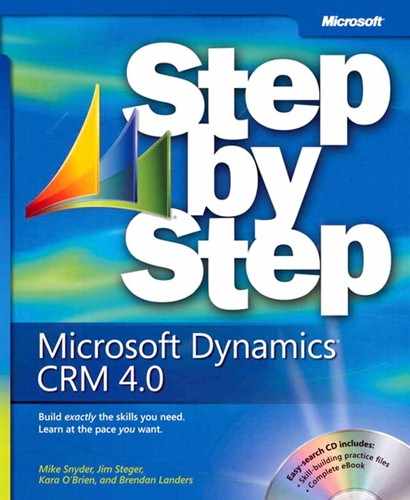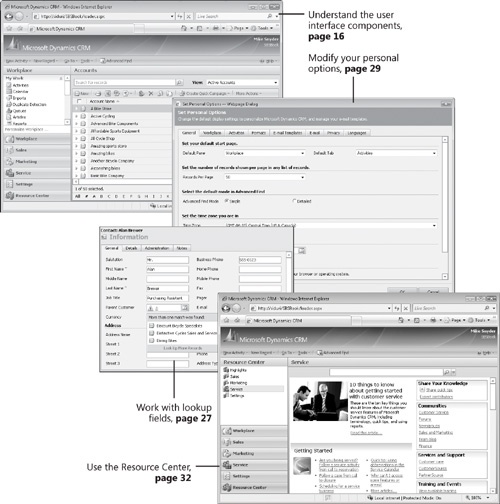Chapter at a Glance
In this chapter, you will learn to: | |
✓ | Understand and work with the components of the user interface. |
✓ | Use Microsoft Dynamics CRM views to work with records. |
✓ | Use Quick Find to search for records in a view. |
✓ | Modify your personal options to suit your individual preferences. |
✓ | Work with lookup fields and use the automatic resolution feature. |
✓ | Use the Resource Center to learn more about Microsoft Dynamics CRM. |
✓ | Access software help within the system. |
Before you can track and manage customer data in Microsoft Dynamics CRM, you need to know how to work in the user interface.
In this chapter, you will learn where to find the areas referenced in this book and how to navigate through the software. You’ll also learn about the resources that can give you more information on how to work with the software.
Troubleshooting
Graphics and operating system–related instructions in this book reflect the Windows Vista user interface. If your computer is running Windows XP and you experience trouble following the instructions as written, refer to the "Information for Readers Running Windows XP" section at the beginning of this book.
Important
You must know the location of your Microsoft Dynamics CRM Web site to work the exercises in this book. Check with your system administrator to verify the Web address if you don’t know it.
Important
The images used in this book reflect the default form and field names in Microsoft Dynamics CRM. Because the software offers extensive customization capabilities, it’s possible that some of the record types or fields have been relabeled in your Microsoft Dynamics CRM environment. If you cannot find the forms, fields, or security roles referenced in this book, contact your system administrator for assistance.
As you learned in Chapter 1, Microsoft Dynamics CRM offers two primary user interfaces: the Web client and Microsoft Dynamics CRM for Outlook. The exercises and examples in this book use the Web client unless otherwise specified. To help you better understand how to navigate the software, we will explain the various components of the user interface.
The following list describes the major components of the user interface:
Application menu toolbar. This toolbar provides buttons that let you quickly create new activities or records. The Go To menu lets you navigate directly to other parts of the user interface. The Tools menu provides access to useful features such as importing data or setting your personal options. The Advanced Find button launches the Advanced Find interface, which you can use to perform ad-hoc data queries. You can also access the system help via a button on the application menu toolbar.
Grid. The grid displays a list of records. Each record set is known as a data view in Microsoft Dynamics CRM. The grid consists of rows and columns of data. The bottom row of the grid provides information about the number of records in the view. The grid also includes an index bar that allows you to quickly filter records in the grid, based on the starting letter you select.
Grid toolbar. The buttons in this toolbar allow you to take action on selected records in the grid. For example, if you select three records in a grid and click a button in the grid toolbar, Microsoft Dynamics CRM will apply that button’s action to the three records you selected. You can also create new records by clicking the New button in the grid toolbar. The actions available in the toolbar vary depending on the type of records displayed.
Application navigation pane. This portion of the user interface provides access to the various types of Microsoft Dynamics CRM data. Simply click a hyperlink in the application navigation pane to view that set of records.
Application areas. Each application area provides a logical grouping of Microsoft Dynamics CRM records. The default application areas are Workplace, Sales, Marketing, Service, Settings, and Resource Center. If you click one of these buttons, Microsoft Dynamics CRM will update the application navigation pane to display the records grouped within that section.
Troubleshooting
Your system administrator has the ability to add, delete, or rename buttons, so your system might look different than the one shown on the previous page.
When you open a record in Microsoft Dynamics CRM, you’ll see additional parts of the user interface.
Entity menu toolbar. The buttons in this toolbar let you take action on the open record, such as saving or uploading an attachment. Click the Microsoft Dynamics button located in the upper-left corner of the record to access additional menu items related to the record.
Entity navigation pane. Similar to the application navigation pane, the entity navigation pane displays different types of Microsoft Dynamics CRM records. However, the entity navigation pane displays only those records that are linked to the open record. For example, clicking the Contacts link in the entity navigation pane of an account record will display only those contacts that have the open account record listed as their parent customer.
Form. The Microsoft Dynamics CRM form displays the data related to the open record. The fields on the entity form are often referred to as attributes.
Form Assistant pane. This tool provides a quick way of locating related records for lookup fields and also allows you to create follow-up activities for the open record.



